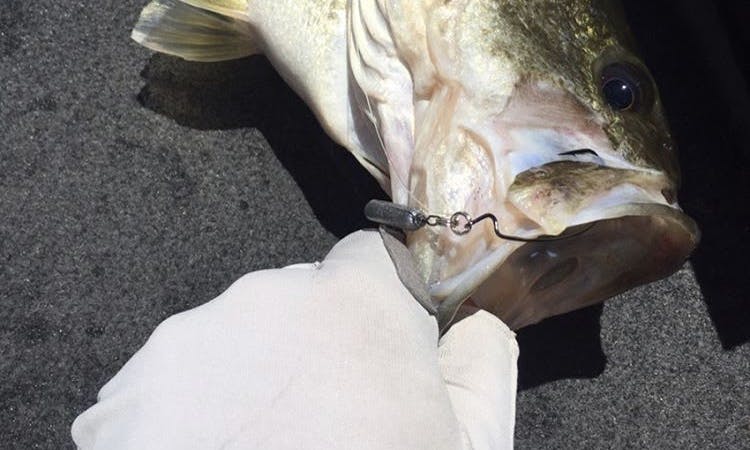
I’ve been fishing the Jika Rig for a while now, and I’ve had some epic days on it. I started fishing the rig at Lake San Vicente in San Diego County. The lake is super clear, super deep, and has a ton of deep trees and brush. The fish hide in those trees year round. There are trees and brush from the bank out to 100 feet of water. By changing the weight of the jika rig, you can fish it shallow and deep. It is a very versatile presentation.
The jika rig is very similar to the Tokyo Rig, but depending on where you are fishing the set up, a jika rig can come in and out of cover a little easier. I put the jika rig together using components that I’m sure many of you already have in your tackle box. The jig rig consists of a hook, split rings, a drop shot weight, and your plastic lure of choice. It is very simple to put together and the only tool you’ll need is a pair of split ring pliers.
In this article I am going to discuss the components I like to use for the Jika Rig, how to put all these components together, and how to actually fish the technique.
Hooks
There are a ton of hook options. There are straight shank options available like an Owner Cover Shot, and other offset shank options like the Owner Offset Worm Hook. My favorites for the jika rig are the Owner Offset Worm Hook or Owner Softbait Hook. You’ll want to choose the hook size based on how large of a bait you’re wanting to fish. For example, I typically have a 3/0 or 4/0 hook when I’m using a 6” plastic worm.
Plastic Bait Options
The options are limitless when it comes to the number of different plastic baits you can choose for the jika rig. Typically, I use a traditional plastic worm in a 6” size. You can also mix things up and use a bait like a 6th Sense Ned Fry, or Stroker Craw. Other good options are soft plastic swimbaits.
Sinker
The drop shot sinker portion of the rig is pretty self explanatory. You’ll need to choose a heavier weight for deep water and a lighter weight for shallow water. You’ll also want to take a pair of split ring pliers and bend open the tight part of the drop shot swivel where you’d put your line when using the weight traditionally. Opening up this part of the weight will enable you to put it on one of the split rings later.
Split Rings
There are a ton of split rings available to you, but the ones I tend to use the most are theOwner Hyperwire Split Rings and the size 2 or 3 are good sizes to use. You’re going to need two of them in order to put the rig together. One will connect to the hook, the other will connect to the drop shot weight, and then you’ll connect everything together.
Putting the Jika Rig Together
Step 1: Connect the hook to one split ring
Using a pair of split ring pliers open one split ring and feed it around the hook eye and attach it to the hook.
Step 2: Open up drop shot swivel
Using a pair of split ring pliers, bend open the snug part of the drop shot swivel. This is the top portion of the swivel where the line is typically cinched up into.
Step 3: Connect drop shot weight to second split ring
Using a pair of split ring pliers, open the second split ring and feed it around the drop shot swivel and connect the drop shot weight to the second split ring
Step 4: Attach the two split rings together
At this point you should have a hook connected to a split ring, and a drop shot weight connected to a separate split ring. Now, using the split ring pliers, open one of the split rings and attach it to the other. Now everything should be connected together.
Step 5: Attach the plastic lure to the hook
Step 6: Tying the Jika Rig to your line
When it comes to tying the Jika Rig to your fishing line, make sure to pay attention to which split ring you are tying to. You want to tie to the split ring that is connected directly to the eye of the hook.
How To Fish the Jika Rig
I like to fish the jika rig just like any other worm technique. You want to feel whatever cover you are fishing. If you are fishing around rock, you want to feel the bait come up and over each individual rock. If you’re fishing around brush or trees, you want to feel the bait come up and over or across each individual tree branch. Fishing it in this manner, will help you detect bites that you would otherwise not feel if you were fishing it faster.
In this article we have covered all the details surrounding the jika rig. We have discussed what components are needed to put this technique together, how to put the rig together, what baits to use on the rig, and how to fish the rig. I’m confident that if you get this rig going, and fish it slow, you will catch some fish!
Check out more Jika Rig content!




